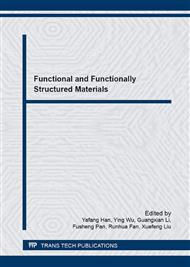[1]
Y. Lin, R. Ran, Y.M. Guo, W. Zhou, R. Cai, J. Wang, Protonconducting fuel cells operating on hydrogen ammonia and hydrazine at intermediate temperatures, Int J Hydrogen Energy. 35(2010)2637-2642.
DOI: 10.1016/j.ijhydene.2009.04.019
Google Scholar
[2]
Ayhan Sarikaya, Vladimir Petrovsky, Fatih Dogan, Development of the anode pore structure and its effects on the performance of solid oxide fuel cells, Int J Hydrogen Energy. 38(2013)1081-1091.
DOI: 10.1016/j.ijhydene.2013.05.160
Google Scholar
[3]
J. Ding, J. Liu, An anode-supported solid oxide fuel cell with spray-coated yttria-stabilized zirconia (YSZ) electrolyte film, Solid State Ionics. 179(2008)1246-1249.
DOI: 10.1016/j.ssi.2008.01.094
Google Scholar
[4]
Axel C. Muller, Dirk Herbstritt, Ellen Ivers-Tiffee, Development of a multilayer anode for solid oxide fuel cells, Solid State Ionics. 152(2002) 537-5 42.
DOI: 10.1016/s0167-2738(02)00357-0
Google Scholar
[5]
Hanna Tikkanen, Crina Suciu, Alex C. Hoffmann, Dip-coating of 8YSZ nanopowder for SOFC applications, Ceramics International. 37(2011) 2869-2877.
DOI: 10.1016/j.ceramint.2011.05.006
Google Scholar
[6]
Minchul Kim, Jaehyung Lee, Joo-Hwan Han, Fabrication of anode support for solid oxide fuel cell using zirconium hydroxide as a pore former, J Power Sources. 196(2011) 2475-2482.
DOI: 10.1016/j.jpowsour.2010.10.109
Google Scholar
[7]
Tatsuya okubo, Hidetoshinagamoto, Low-temperature preparation of nanostructured zirconia and YSZ by sol-gel processing, J Mater Sci. 30 (1995) 749-756.
DOI: 10.1007/bf00356338
Google Scholar
[8]
Horri B A, Selomulya C, Wang H, Characteristics of Ni/YSZ ceramic anode prepared using carbon microspheres as a pore former, Int J Hydrogen Energy. 37(2012) 15311-15319.
DOI: 10.1016/j.ijhydene.2012.07.108
Google Scholar
[9]
D. Simwonis, H. Thullen, F.J. Dias, A. Naoumidis, D. Stover, Properties of Ni/YSZ porous cermets for SOFC anode substrates prepared by tape casting and coat-mix process, J Mater Process Technol. 92(1999) 107-111.
DOI: 10.1016/s0924-0136(99)00214-9
Google Scholar
[10]
T. Mahata, S.R. Nair, R.K. Lenka, P.K. Sinha, Fabrication of Ni-YSZ anode supported tubular SOFC through iso-pressing and co-firing route, Int J Hydrogen Energy. 37( 2012)3874-3882.
DOI: 10.1016/j.ijhydene.2011.04.207
Google Scholar
[11]
Basu RN, Das Sharma A, Dutta A, Mukhopadhyay J, Processing of high performance anode supported planar solid oxide fuel cells, Int J Hydrogen Energy. 33( 2008)5748-5754.
DOI: 10.1016/j.ijhydene.2008.06.073
Google Scholar
[12]
Sanson A, Pinasco P, Roncari E, Influence of pore formers on slurry composition and microstructure of tape cast supporting anodes for SOFCs, Eur Ceram Soc. 28( 2008)1221-1226.
DOI: 10.1016/j.jeurceramsoc.2007.10.001
Google Scholar
[13]
Bahman Amini Horri, Cordelia Selomulya, Huanting Wang, Electrochemical characteristics and performance of anode-supported SOFCs fabricated using carbon microspheres as a pore-former, Int J Hydrogen Energy. 37( 2012)19045-19054.
DOI: 10.1016/j.ijhydene.2012.10.005
Google Scholar
[14]
C.X. Lia, C.J. Lia, L.J. Guo, Effect of composition of NiO/YSZ anode on the polarization characteristics of SOFC fabricated by atmospheric plasma spraying, Int J Hydrogen Energy. 35(2010)2964-2969.
DOI: 10.1016/j.ijhydene.2009.05.041
Google Scholar
[15]
Ryan M.C. Clemmer,StephenF. Corbin, Influence of porous composite microstructure on the processing and properties of solid oxide fuel cell anodes, Solid State Ionics. 166 (2004) 251-259.
DOI: 10.1016/j.ssi.2003.12.009
Google Scholar
[16]
Park, Y. M. and Choi, G. M, Microstructure and electrical properties of YSZ–NiO composites, Solid State Ionics. 120(1999)265–274.
DOI: 10.1016/s0167-2738(99)00010-7
Google Scholar
[17]
Y.H. Yin, W. Zhu, C.G. Xia, G.Y. Meng, Electrochemical performance of IT-SOFCs with a double-layer anode, Power Sources. 132(2004) 36-41.
Google Scholar
[18]
Sun Dong Kim, Jong-Jin Leea, Hwan Moona, Sang-Hoon Hyuna, Jooho Moona, Joosun Kimb, Hae-Weon Leeb, Effects of anode and electrolyte microstructures on performance of solid oxide fuel cells, J Power Sources. 169(2007) 265-270.
DOI: 10.1016/j.jpowsour.2007.03.046
Google Scholar
[19]
P. Duran, J. Tartaj, F. Capel, C. Moure, Processing and characterization of a fine nickel oxide/zirconia/composite prepared by polymeric complex solution synthesis, J Eur. Ceram. Soc. 23(2003)2125-2133.
DOI: 10.1016/s0955-2219(03)00028-1
Google Scholar
[20]
Jong-Yeol Yoo, Chun-Kang Cho a, In-Jin Shon, Ki-Tae Lee, Preparation of porous Ni–YSZ cermet anodes for solid oxide fuel cells by high frequency induction heated sintering, Material Letters 65(2011) 2066–69.
DOI: 10.1016/j.matlet.2011.04.032
Google Scholar
[21]
M. Letilly, O. Joubert, M. -T. Caldes, A. Le Gal La Salle, Tape casting fabrication, co-sintering and optimization of anode/electrolyte assemblies for SOFC based on BIT07-Ni/BIT07, Int J Hydrogen Energy. 37( 2012)4346-4355.
DOI: 10.1016/j.ijhydene.2011.11.140
Google Scholar
[22]
Mingyi L, Bo Y, Jingming X, Jing C, Influence of pore formers on physical properties and microstructures of supporting cathodes of solid oxide electrolysis cells, Int J Hydrogen Energy. 35( 2010)2670-2674.
DOI: 10.1016/j.ijhydene.2009.04.027
Google Scholar


